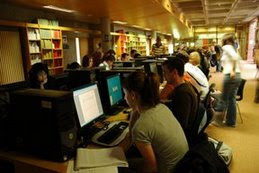Tagging is an open and informal way of allowing users to describe online content (webpages, pictures & posts) by associating keywords.
Please watch this short video to explain Social bookmarking in plain English
(A YouTube video created by Common Craft).
The Horizon report (2007) has this to say: "A little group of Web 2.0 technologies—tagging and folksonomic tools, social bookmarking sites, and sites that make it easy to contribute ideas and content—is placing the power of media creation and distribution firmly into the hands of the people formerly known as the audience” (Rosen, 2006).
No longer satisfied to be consumers of content, today’s audience create content as well. Producing, commenting, and classifying are just as important as the more passive tasks of searching, reading, watching, and listening."
We’ll be looking more closely at Web 2.0 applications that take serious advantage of tagging (we've already looked at some - Flickr and blogs both use tags). Tagging, remember, allows you to describe and categorise online content - webpages, pictures, posts, etc.
It is considered a folksonomy, aka an unstructured categorisation scheme, unlike the more formal taxonomies that require adherence to strict rules and vocabularies.
This week we’ll look at still more innovative applications that take great advantage of tagging – Del.icio.us and Technorati.
Del.icio.us is a social bookmarking site that lets you save bookmarks to a central location (so you can access your web favourites regardless of the browser or computer you're using) and then describe them all with tags so that you can easily find them again.
How is that social? Well, in addition to tagging your bookmarks, you can see how other users have tagged the same links and see related websites are important to them. This is an excellent way to find websites that may be of interest to you. Del.icio.us even offers RSS feeds {link to blog} - you can create a shared bookmark site (say, for your team) and receive news every time a new link is added (say, when one of your colleagues add a new link). It is also being used to assist with collaborative online reference.
Discovery exercise:
1.Take a look around Del.icio.us using the 23 Things @ UL account we have created for this project. (You will find it here, under the user "23ThingsUL").
Note: In this account you will find lots of resources that have been highlighted or used throughout the course of the 23 things programme. Explore the site options and try clicking on a bookmark that has also been bookmarked by alot of users. Can you see the comments they added about this bookmark or the tags that they used to categorise this reference?
2.How would you use a del.icio.us in your work environment, would you find it useful, what are the advantages?
Optional
3.Create your own Del.icio.us account, add your own bookmarks and explore the site.
Subscribe to:
Post Comments (Atom)







No comments:
Post a Comment